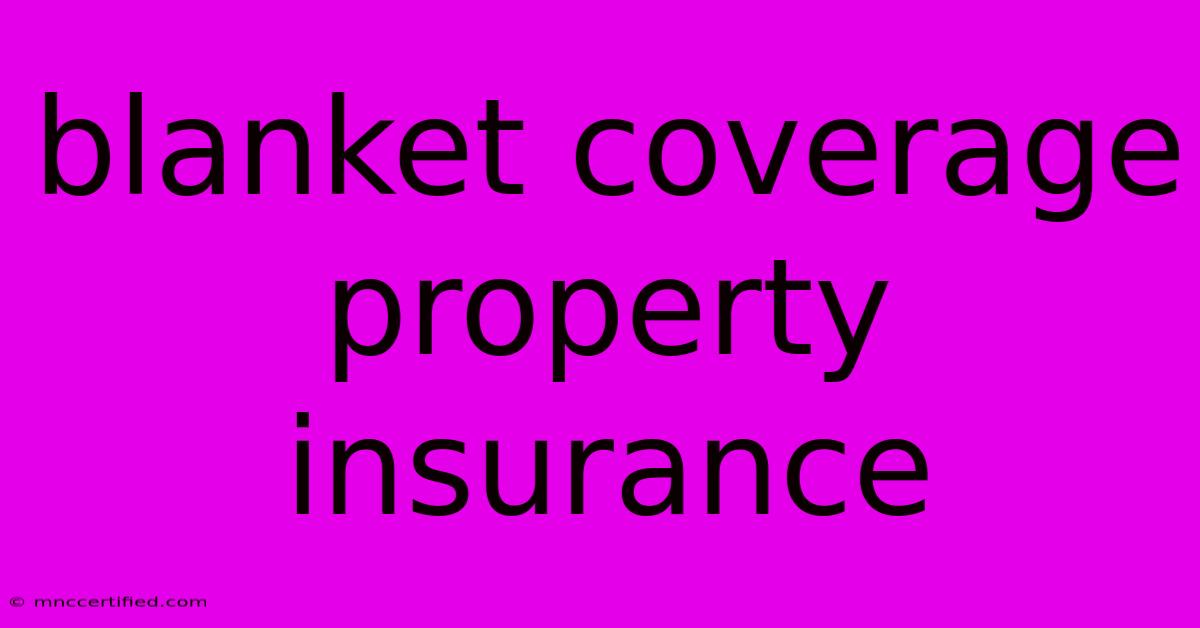Blanket Coverage Property Insurance

Table of Contents
Blanket Coverage Property Insurance: A Comprehensive Guide
In the world of insurance, understanding the nuances of different coverage types is crucial. One such type, often used by businesses and property owners with multiple locations, is blanket coverage property insurance. This comprehensive guide will delve into the intricacies of blanket coverage, explaining its benefits, features, and how it can protect your assets.
What is Blanket Coverage Property Insurance?
Blanket coverage property insurance is a type of insurance policy that provides coverage for a group of properties under a single policy, rather than individual policies for each location. This type of insurance is often preferred by businesses with multiple locations, such as retail chains, restaurants, or manufacturing facilities.
Key Features of Blanket Coverage:
- Single Policy: One policy covers all designated properties, simplifying administration and potentially reducing premiums.
- Aggregate Limits: Instead of individual limits for each property, a blanket policy sets an aggregate limit for all covered properties.
- Flexibility: Allows for adjustments in coverage based on property value changes, making it adaptable to business growth or contraction.
- Centralized Management: Streamlines claims handling and communication, making the process efficient.
Benefits of Blanket Coverage Property Insurance
For businesses:
- Cost Savings: A single policy often leads to lower premiums than individual policies.
- Simplified Management: Reduces administrative burdens and streamlines risk management.
- Enhanced Coverage: Offers comprehensive protection for all covered properties under one umbrella.
- Improved Flexibility: Adaptable to changing needs, accommodating property additions or renovations.
For homeowners:
- Comprehensive Protection: Offers protection for multiple homes or properties under a single policy.
- Peace of Mind: Simplifies insurance management, offering reassurance and reducing stress.
- Potential Cost Savings: Can lead to lower premiums compared to individual policies.
How Blanket Coverage Works
Blanket coverage operates based on aggregate limits, meaning there is a maximum amount of coverage for all covered properties combined. When a claim is filed, the insurer will pay up to the aggregate limit, taking into account the amount paid for any previous claims during the policy period.
Important Considerations:
- Specific Perils: Blanket coverage typically covers common perils like fire, theft, and vandalism, but specific perils and exclusions may vary depending on the policy.
- Valuation Methods: Different valuation methods may be used to determine the amount of coverage, such as replacement cost or actual cash value.
- Exclusions: Certain perils or circumstances may be excluded from coverage, like earthquakes or floods.
Choosing the Right Blanket Coverage
Selecting the right blanket coverage policy requires a thorough understanding of your specific needs and risk profile. Consider factors like:
- Number of Properties: The size of your property portfolio will influence your policy requirements.
- Value of Properties: The overall value of your properties will determine the required coverage limit.
- Specific Perils: The risks specific to your properties, such as fire hazards or theft risk, need to be factored in.
- Budget: Your financial capacity and risk tolerance will play a role in choosing the most suitable policy.
Consulting an insurance agent or broker can help you navigate the complexities of blanket coverage and identify the best policy for your needs.
Conclusion
Blanket coverage property insurance offers a comprehensive and often cost-effective way to protect multiple properties under a single policy. By understanding the key features, benefits, and considerations associated with blanket coverage, businesses and homeowners can make informed decisions and ensure adequate protection for their assets. Remember to carefully review the policy terms and conditions to ensure it aligns with your specific requirements and risk profile.

Thank you for visiting our website wich cover about Blanket Coverage Property Insurance. We hope the information provided has been useful to you. Feel free to contact us if you have any questions or need further assistance. See you next time and dont miss to bookmark.
Featured Posts
-
Costco Butter Recall Food Labeling Lessons
Nov 13, 2024
-
Where To Watch Nba Cup Online In 2024
Nov 13, 2024
-
New Stop Smoking Pill Nhs Rollout
Nov 13, 2024
-
Skai Jackson Former Disney Star Expecting First Baby
Nov 13, 2024
-
Denzel Washington Discusses Retirement Black Panther 3 Potential
Nov 13, 2024